This post has been in the works since way back in April… Countless hours of editing and collaboration have been wasted bringing this to you now, four months later. So, please enjoy… more photos and stories hopefully to come soon.
Love, Jason
. . . . .
By Julianne Dodds
One day late in April we decided to drive up to Malval, where there is an old mill as well as ruins of a millennium-old castle. The fields on either side of the rural road were bright yellow, completely filled with dandelions. It was a beautiful sight: the sunny flowers are not really considered much of a weed in France and are allowed to grow sans herbicide. Penelope made a casual comment about making dandelion wine, but it really fired up Jason’s imagination. He’d never even heard of it before, but suddenly he had a new project.
Neither of us had ever tasted dandelion wine or made any wine before, but luckily Google had us taken care of. We found a few intriguing recipes which we then synthesized into one master recipe.
The next step was to pick our flowers. After running to the village thrift store for our genuine French costumes we headed out into a neighbor’s cow field.
Down the road and under the electric fence, carrying our baskets and wading out into the sea of yellow. It was charming to sit out in the sun and fill our baskets with flower heads. We would clear out an area of the largest flowers and then move on, leaving a trail of negative dandelion space in our wake. Watch out Robert Smithson, l’art de terre is about to get revolutionized.
Two hours of picking had our baskets overflowing. The sun was still up as we sat down for part two: removing the petals from the heads. Some recipes said this was unnecessary, but others said that leaving the greens would make the wine bitter. Better safe than sorry, we told ourselves. After about 30 minutes of plucking, Jason declared that I was better suited for the job, as my fingers were smaller and used to meticulous needlework. Yeah, right. The sun soon set as I sat at the kitchen table, plucking petal after petal. I felt like Horton sifting through a field of clover, searching for the one with his Who-filled speck of dust. Meanwhile, Jason was boiling the loose petals into a foul smelling dandelion juice. By the time all the bowls and tureens in the house were filled and covered, I had only gotten through about half the flowers we had picked. But at this point it was 3 AM and we had been working on the damn project for eight hours, and we didn’t have any more room for dandelion juice. With 10 liters of opaque yellow water we hauled ourselves up to bed.
Once the juice was completely infused with dandelion extract we had to strain the liquid. First we skimmed out the petals by hand, molding them into balls and squeezing out the water. Finally my tiny, delicate, very lady-like hands got a rest, as Jason’s work-worn hands could do this task much better than mine.
Once all the petals were removed we poured the juice into a 20 L plastic jug. We stretched my stockings over a filter to strain out as much pollen as possible. Then we added the rest of our ingredients: zest and juice from oranges and lemons, cloves, yeast, and about 7 kg sugar. We twisted the lid back over the mouth of the carboy and set it aside. Now all we had to do was wait for the wine.
After it had been fermenting for a few days it was time to move the wine into bottles. These had been saved and washed over many weeks.
The first task when it came to bottling was to make sure the bottles were properly cleaned and sterilized. Then the wine was filtered well, and the decanted into the bottles. The bottles then remain uncorked for eight to twelve weeks as the wine ferments. The fermentation process causes the release of carbon dioxide which can cause the bottles to explode if they are corked too soon. Once the fermentation process is completed, the wine is ready to be consumed and the bottle may be corked and allowed to ‘mellow’ further.
As the wine sat in uncorked bottles for weeks, many industrious ants met their maker in our sugary eau de morte, but c’est la vie. At one point we re-strained the bottles, pouring carefully to leave behind the settled pollen as well as the insect carcasses. The wine still had a while to go before the fermentation bubbles stopped rising, but it was time for me to leave France. I filled a 1L bottle with an air-releasing cork with the sweet yellow wine, wrapped it in my sweatshirt and extra clothes, and hoped for the best as I placed it in my checked suitcase. Luckily it survived its trip across the Atlantic quite well, and I was so excited to finally drink a glass. I waited until arriving in Maggie Valley, NC, to share it with Jason’s mom. It was so sweet and tangy: very delicious but I’m not sure what foods it would go with.
Some might say it wasn’t the best idea to make 24 bottles of a wine we’d never tasted before, but really they should know better than to give us that kind of advice. Not only did we make this mystery wine, we also documented the entire thing and made a stop-motion movie about the whole affair. So enjoy the film, and wait until next summer when my own Dandewine Americain will be vintaged.
Photo Gallery:
- Dandelion Fields at Malval
- A Harvest to be Proud Of!
- Piles of Petals
- Petals Steeping
- Straining the Juice
- Decanting into Bottles
- Beautiful Corked Bottles
The Recipe:
Dandelion wine does not require any special equipment to make. Just dandelions, some sugar and yeast, oranges and lemons, and pots to boil water in. This recipe uses cloves and ginger, which I think give it a nice touch. If you have dandelions around, give it a try! We Made 20 liters- but you may want to start with smaller amounts… the recipe below will yield about 4 liters.
* 1 package dried yeast
* 50ml cup warm water
* 2 Liters dandelion blossoms
* 4 Liters water
* 250 ml orange juice
* 3 tablespoons fresh lemon juice
* 3 tablespoons fresh lime juice
* 8 whole cloves
* 1/2 teaspoon powdered ginger
* 3 tablespoons coarsely chopped orange peel
* 1 tablespoon coarsely chopped lemon peel
* 6 cups sugar
Dissolve the yeast in the warm water. Set aside.
Wash the dandelion blossoms well. Put them in the water with the orange, lemon and lime juices. Bring to a boil and continue to boil a few minutes. Let stand 24-48 hours, then strain and pour into large carboy or jug. Add the cloves, ginger, orange and lemon peel, and sugar. Shake well and then let it rest for one week while the fermentation begins. Then strain again and pour into bottles. Allow uncorked bottles to set in a darkened place for three to six weeks. Then cork and store bottles in a cool place.
Note: Choose dandelions from an open field far from any insecticide spraying. Pick early in the season when the leaves of the plant are still tender. Flowers that have just opened are best.
Enjoy your vintage and please consume responsibly!

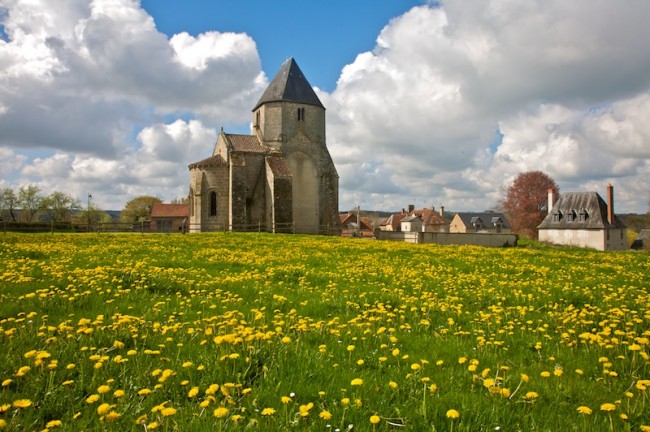
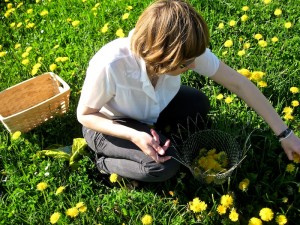
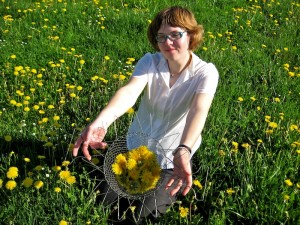
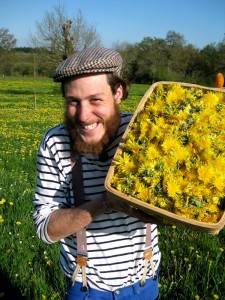
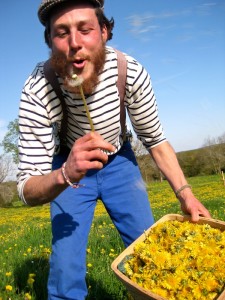

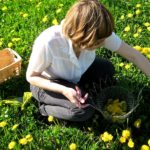

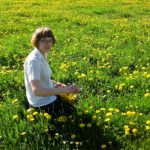

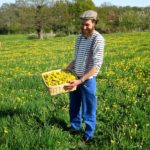
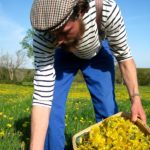
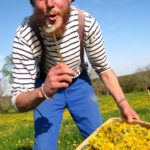

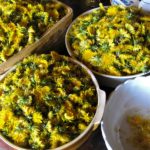
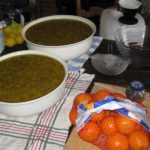
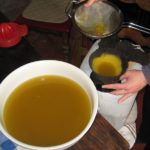
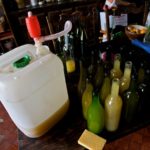
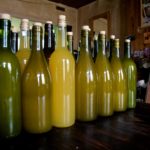
Dear Julianne, Your mom forwarded your dandy tale of the dandelion wine, which I really enjoyed reading! It sounds like it might be good with dessert, or as an aperitif. I do admire your courage for forging ahead and making it without knowing how it tasted! Very inspirational! I’ll stay tuned. Take care, Marcia
I feel so validated seeing this post up here. I think this and my photo of Rick Steves sums up the 6 months I spent in Europe. I’ve been eyeballing fancy glass bottles at garage sales, thinking about the 2010 harvest.
Dear Julianne, Thanks for your reply. I really enjoyed seeing the photo of you with Rick Steeves and reading about how you accidentally met up with him – some story! His show is great, isn’t it? And he looks very pleasant – the same as in his travel videos. Continue having lots of adventures – and writing about them – and taking photos (for which you have a real knack)! Love, Marcia
I absolutely love this. Never before heard of Dandewine. Thanks for this post. I’m so excited to try it!!!